OR/15/042 Localities
| MAURICE, L, FARRANT, A R, BUTCHER, A AND ATKINSON, T C. 2015. Groundwater in Cretaceous carbonates: KG@B field trip 21st June 2015. British Geological Survey Internal Report, OR/15/042. |
Mirams copse stream sink
Mirams Copse stream sink (Figure 7) is a fairly typical chalk stream sink. It is situated about 80 m above sea level and is fed by small springs in the Palaeogene and some very local surface runoff. It has a maximum flow of about 5–10 l/s, when water sometimes backs up to form a small pool. It has no flow following dry periods. The stream sink is located on thin Palaeogene deposits overlying the Chalk, and the unsaturated zone is about 17–24 m thick.
Initial tracer testing using the optical brightener Photine CU produced negative results in 6 different tracer tests that involved injecting progressively more tracer (125 to 5000 mls of a 20% solution). Monitoring was carried out using passive cotton detectors at 13 spring, borehole and river sites (Figure 8). During a later test using bacteriophage, tracer was conclusively detected 1.7 km away at the Blue Pool spring. Groundwater velocities were very rapid — 4.3 km/d based on first arrival of the tracer. However tracer attenuation was high: <0.00005 % of the tracer was recovered. This was a big contrast to tracer tests from Smithcroft Copse stream sink (Figure 8) which showed similar rapid flow rates of 5 km/day but combined with much lower attenuation (about 25 % of the tracer was recovered).
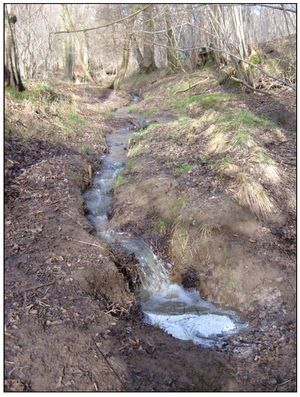
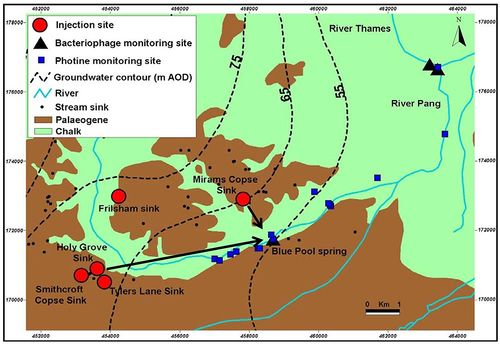
Rushall Farm Quarry
Streams sinking into the Chalk commonly do so at or near the boundary between the Chalk and the overlying Palaeogene deposits. The unconformable contact between these strata is often characterised by dissolution pipes which are visible in quarries, and present a geotechnical hazard during engineering projects.
The Quarry at Rushall Farm gives a clear section through the Palaeogene- Chalk contact (Figure 9). The unconformity surface is marked by small scale dissolution pipes infilled with sand and clay derived from the overlying strata. Some small conduits are visible in the Chalk (Figure 10).


Blue pool spring
The Blue Pool spring comprises a series of powerful upwellings that form several pools (Figure 11). The spring is at an elevation of about 55–60 m above sea level. The upwellings combine to form a single channel which discharges into the River Pang (Figure 12). The Blue Pool has a fairly consistent flow of around 200 l/s and continued to have a good flow throughout the 1976 drought. Water level monitoring over the past few years in the outlet channel has revealed a seasonal increase in stage, and a rapid response to rainfall that only occurs after the seasonal increase in stage.
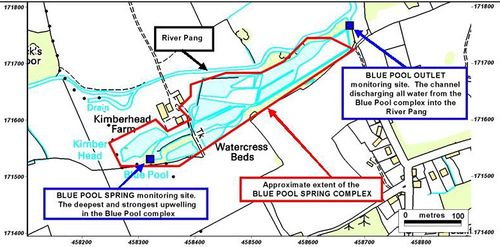
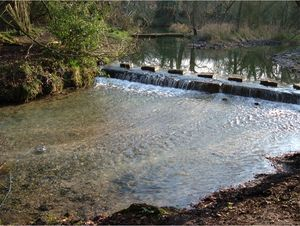
The first tracer tests demonstrating rapid groundwater flow to the Blue Pool were carried out from Holly Grove and Tylers Lane stream sinks (Banks et al., 1994[1]). Subsequent quantitative tests revealed rapid groundwater flow from Smithcroft Copse and Mirams Copse stream sinks, combined with variable attenuation (Maurice et al., 2010[2]). Attenuation can be low (Figure 13). 610 grams of a 70% solution of Sodium Fluorescein injected at Smithcroft Copse stream sink was visible at the Blue Pool, 5.1 km away, after a travel time of only 24 hours. The dye concentration at the spring was about 60 ug/l, and the tracer recovery was about 20%. This clearly demonstrates the vulnerability of the Chalk aquifer to pollution.
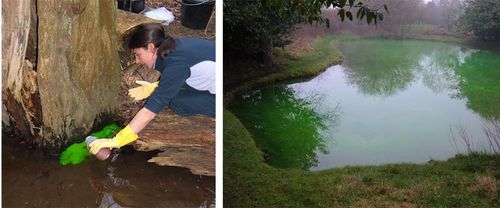
Calversley Farm Borehole
Borehole investigations in the Chalk have revealed that most groundwater flow occurs through dissolutional fissures and conduits (Schurch and Buckley 2002[3]; Maurice et al., 2012[4]). Calversley Farm borehole is an Environment Agency groundwater level monitoring borehole. Imaging of the borehole walls has shown that it intercepts a number of dissolutional fissures and conduits, and that these may be sediment filled (Figure 14). We will use a borehole CCTV system which can be moved around to look at the borehole walls from different angles.
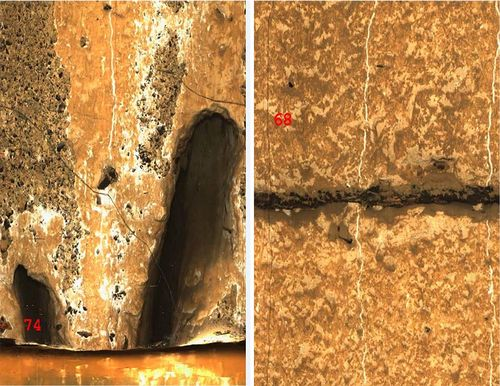
Groundwater ecology sampling has found a diverse community of invertebrates in Calversely Farm borehole including Niphargus kochianus, copepoda, springtails, nematoda, oligocheata and mites. The most common invertebrate found in the borehole is the amphipod Niphargus kochianus (Figure 15). This is a stygobitic species, usually between 0.5 and 5 mm in length, which is only found in groundwater, and is specially adapted to live in an environment with no light and limited resources. Genetic work has demonstrated that the British population of Niphargus kochianus separated from European populations about 2.9 million years, so it is an ancient endemic lineage that provides an important contribution to biodiversity (McInerary et al., 2014[5]). Stygobitic invertebrates are widespread in the Chalk and a recent study found them in more than 70% of boreholes sampled. Whilst we have not observed the stygobitic invertebrates in Calversley Farm borehole with CCTV before, we have observed them using CCTV at another borehole in the catchment (Figure 16).
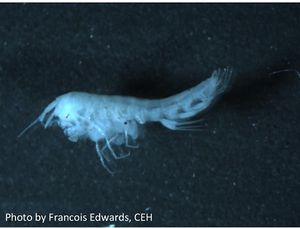
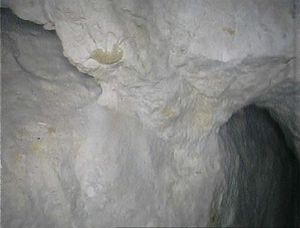
Yattendon stream sink
The Yattendon stream sink is an unusual example of a Chalk stream sink where the stream can be observed to sink into a cavity within the Chalk. At this site, a small stream has eroded through the Palaeogene material to reveal the Chalk underneath (Figure 17). The water sinks into a narrow vadose canyon, disappearing into a chalk cave about 30 cm wide and several metres deep (Figure 18). Most streams sinking into the Chalk sink into clay and sand deposits overlying the Chalk and therefore the karst features within the Chalk cannot be observed. It is possible that many other Chalk stream sinks are underlain by features like this which are concealed under the Palaeogene sediments.
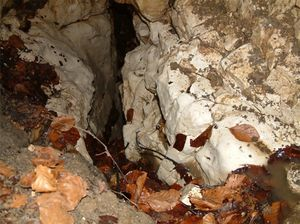
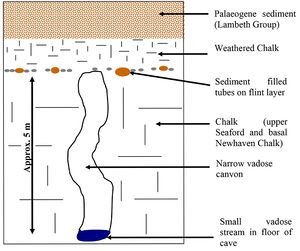
References
- ↑ BANKS, D, DAVIES, C, and DAVIES, W. 1995. The Chalk as a karstic aquifer: evidence from a tracer test at Stanford Dingley, Berkshire, UK. Quarterly Journal of Engineering Geology 28, S31–S38.
- ↑ MAURICE, L D, ATKINSON, T C, WILLIAMS, A T, BARKER and FARRANT, A R. 2010. Catchment Scale tracer testing from karstic features in a porous limestone. Journal of Hydrology 389 (1–2), 31–41.
- ↑ SCHÜRCH, M and BUCKLEY, D. 2002. Integrating geophysical and hydrochemical borehole log measurements to characterise the Chalk aquifer, Berkshire, United Kingdom. Hydrogeology Journal 10 (6), 610–627
- ↑ MAURICE, L D, ATKINSON, T C, BARKER, WILLIAMS, A T and GALLAGHER, A. 2012. The nature and distribution of flowing features in a porous limestone aquifer with small-scale karstification. Journal of Hydrology 438–439, 3–15.
- ↑ MCINERNEY, C E, MAURICE, L, ROBERTSON A L, KNIGHT, L R FD, ARNSHEIDT, J, VENDITTI, C, DOOLEY, J S G, MATHERS, T, MATTHIJS, S, ERIKKSON, K, PROUDLOVE, G, HANFLING, B. 2014. The Ancient Britons: Groundwater fauna survived extreme climate changes over tens of millions of years across NW Europe. Molecular Ecology 23, 1153–1166 doi:10.1111/mec.12664